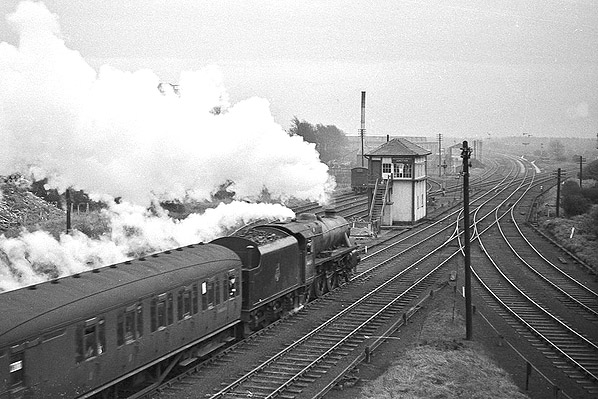
Looking south at Fazakerley North Junction as a Grand National special passes on a return working from Aintree Central to Manchester Central on 25 March 1961. The line leading off to the right was the freight only Langton Dock branch. Beyond the signal box is the Fazakerley North Junction. The line going right ran to Fazakerley West Junction and onward to Huskisson. The line going left is the main line of the North Liverpool Extension Line to Halewood.
Photo by Ted Baxendale from the Kerry Parker Flickr photostream
The Huskisson branch diverged from the North Liverpool Extension Line at a point just under a mile east of Walton-on-the-Hill. The junction was named Fazakerley South. Fazakerley was a district about half-a-mile north-east of the line. Junctions with the name Walton already existed on the Lancashire & Yorkshire Railway’s (LYR) Liverpool and Preston line, and it is possible that the CLC chose Fazakerley for this reason. The North Liverpool Extension Line opened initially from Halewood to Walton-on-the-Hill passenger station, for passenger services only, on 1 December 1879. It was not until 1 July 1880 that goods services started, when the line to Huskisson opened. On 13 July 1880 the line from Fazakerley South Junction to Aintree opened for a horse racing event there. At the same time a 51-chain line, that diverged from the Huskisson branch a short distance north-east of Walton-on-the-Hill and curved north to the North Liverpool Extension Line, opened for the same purpose. The point at which it diverged from the Huskisson branch was called Fazakerley West Junction, and where it connected to the North Liverpool line was known as Fazakerley North Junction. With the opening of these lines the Walton triangle was formed. As the junctions were called Fazakerley, the triangle was referred to in official documents by that name even though it was actually closer to Walton. Locally it was referred to as the ‘Walton Triangle’ and is known better by that name.

Looking north-east from Fazakerley West Junction in 1965. The line to Fazakerley North Junction runs off towards the left. Curving to the right are is the line to Fazakerley South Junction and on either side of it there are sidings.
Photo by Jim Peden
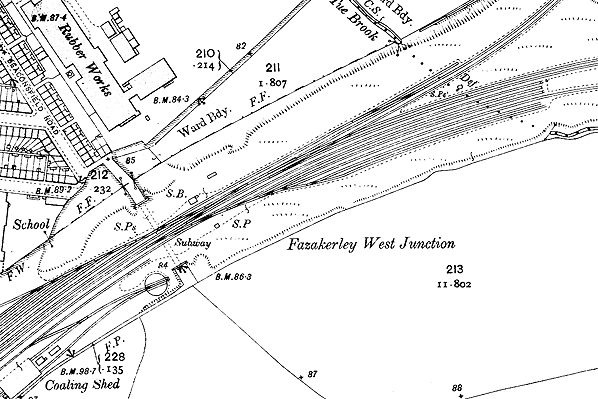
Fazakerley West Junction as it was in 1908.
In the early years the only part of the Walton Triangle that was anything more than a double-track junction was at Fazakerley West where there were a number of sidings and, just to the south-west, Walton-on-the-Hill locomotive shed which opened on 13 May 1881. At Fazakerley West Junction a CLC type SG/CL1 signal box was provided on the north side of the line. It opened with the line on 1 December 1879 and was of timber construction with a 26-lever frame. At Fazakerley South Junction a timber box was provided which opened with the line on 1 December 1879. It was on an embankment east of the line and supported on timber legs. It was replaced with a CLC type CL1a box on 23 October 1898, also of timber and with a 26-lever frame. The junction at Fazakerley North was provided with a CLC type St/CL timber signal box with a 27-lever frame on the east side of the line.
At both Fazakerley West and North junctions there were public rights of way that crossed the route of the line. Owing to the width of the line at these locations lengthy pedestrian tunnels were constructed to carry the footpath routes under the lines. Other features included a five-arch bridge that carried Hartley Avenue over the line north of the Fazakerley North Junction.
On 1 September 1884 the Southport & Cheshire Lines Extension Railway (S&CLER) opened from Aintree to Southport Lord Street. The station at Aintree, provided for race day traffic, opened as a public station. The opening of the line brought a great deal of extra traffic to the eastern side of the triangle.
The first major development on the Walton triangle was at Fazakerley North Junction. One of the CLC partners, the MR, wanted a large depot of its own in the rapidly expanding north docks. They opened a 2-mile 15-chain branch from Fazakerley North Junction to a goods station at Langton Dock on 1 June 1885. The branch diverged from the North Liverpool Extension Line just north of the Fazakerley North Junction at Fazakerley Junction, and sidings were created there. An extra span was built onto the Hartley Avenue bridge on its west side to carry Harley Lane over the Langton branch. It differed vfrom the rest of the bridge structure in that it was not a stone arch. The expansion at north junction saw the opening of a replacement signal box 350yd north of the original in November 1889. The new box was a CLC type CL1a with a 40-lever frame. Further developments took place when Harleys opened a Jam factory east of the line at Fazakerley North Junction. Connections were made with the CLC and further sidings laid out. Jacobs, the biscuit-maker, also opened a factory adjacent to the line and had its own sidings that connected to the CLC at the north junction.
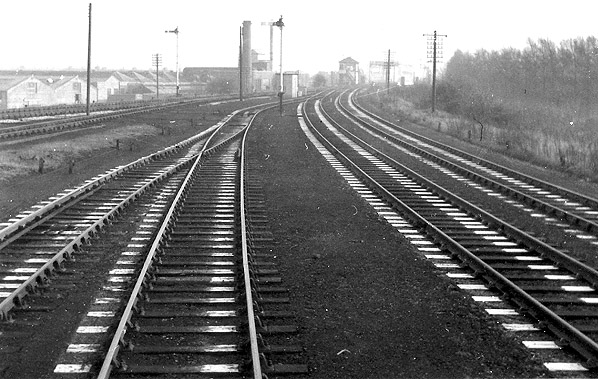
Looking south towards Fazakerley South Junction in 1965. The two lines to the right are the Huskisson branch and lead to Fazakerley West Junction and onward to Huskisson.The south junction up line Huskisson branch home signal is seen straight ahead. To the left of the Huskisson branch are two lines meging into one that are the southern end of the up and down group sidings. Far left can be seen the main line from Aintree with its south junction home signal.
Photo by Jim Peden
On 29 March 1914 a new signal box opened at Fazakerley West junction. It was a CLC type CL2b timber box with a 60-lever frame. In 1915 passenger services between Fazakerley South and West Junctions ceased when the Walton-on-the-Hill – Liverpool Central service was withdrawn. This left the Huskisson branch as a purely freight railway.
The next phase of development took place along the Fazakerley West Junction – Fazakerley South Junction spur. During the Great War sidings were laid out on the north side of the line within the triangle itself. Interestingly the sidings were named the Walton Up Group and the Walton Down Group sidings. During the Second World War they expanded further.
With the nationalisation of the railways on 1 January 1948 the CLC became part of British Railways London Midland Region. The former S&CLER line to Southport Lord Street closed to passenger services on 7 January 1952. It closed from Altcar & Hillhouse to Southport for goods on 7 July 1952 (the remaining section from Aintree to Altcar closing on 6 June 1959). In 1958 the turntable at Walton-on-the-Hill shed failed and was deemed too expensive to repair. Locomotives from the depot were then turned using the triangle.
The Walton Triangle remained a busy railway location until the 1960s. On 15 December 1963 Walton-on-the-Hill engine shed closed. On 19 June 1966 the line between Fazakerley West Junction and Huskisson was singled. The Up and Down sidings were taken out of use on 17 April 1967: they were disconnected from the main line on 12 May 1968 and lifted shortly after. On 12 May 1968 the line between Fazakerley West and Fazakerley North Junction was taken out of use and had been lifted by mid-summer 1968.
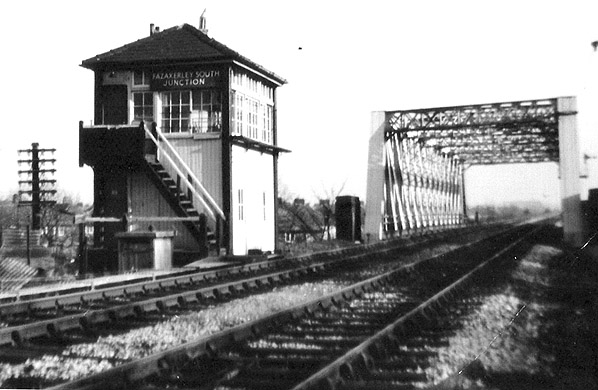
Looking south towards Halewood from Fazakerley South Junction in 1968. The girder bridge seen beyond the signal box spans Walton Hall Avenue and was installed in 1930.
Photo by Tony Graham
On 22 September 1968 Fazakerley North Junction signal box was destroyed by fire. This prevented trains from using the line between the south junction and Aintree and the Langton branch. Official closure came on 1 January 1969, and the track as far as Aintree Central and down to Langton was lifted in August 1969. Fazakerley South Junction signal box closed on 2 January 1969 but it had been out of use since 22 September 1968. On 22 November 1969 Fazakerley West Junction signal box burnt down. Since the closure of the line to north junction its only real purpose was to control the point at which the line became a single track down to Huskisson. The solution was to single the line from west junction to Knotty Ash. This came into effect on 30 November 1969 when the signal box was officially closed. All that remained of the once extensive Walton triangle was a single track on its southern side. It saw its last traffic in July 1975, and the line was officially out of use by August of the same year. Track-lifting had taken place by February 1979.
In the early 1980s the Walton Triangle was developed with housing estates. The only section of it that remained after the house-building was its eastern side which became Liverpool Loop Line footpath and cycleway - part of the Trans-Pennine Trail.
The 8D Association - Dedicated to promoting the history of South Lancashire and North Cheshire railways. Web Site
With special thanks to Tony Graham.
Sources:
- An Illustrated History of The Cheshire Lines Committee - P Bolger - Heyday Publishing Company 1984
- Cheshire Lines Committee Signal Box Register, M J Addison & J D Dixon 1996
See also: Walton-on-the-Hill, Clubmoor and Warbreck stations
See features: Walton-on-the-Hill Locomotive Shed & Walton-on-the-Hill tunnels
|

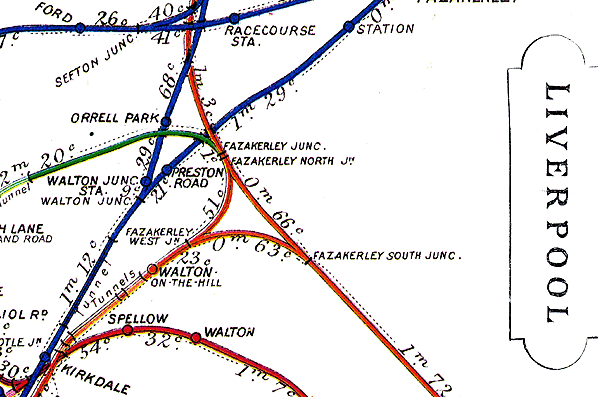






 Home Page
Home Page